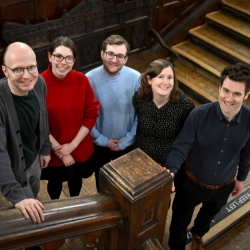Video-enabled glasses have the potential to
support patients at risk of falls by allowing medical staff to monitor how they
move around their homes and their community. However, with privacy concerns at
the forefront of this new technology, academics at ║┌┴Ž▓╗┤“ņ╚ have
carried out a cutting-edge study into the ethical use of AI to ensure video
footage can be obscured to ensure patient privacy.
Traditionally patients at risk of falls have
been assessed based on information they provide themselves in diaries or during
short in-clinic observation appointments. However, these do not provide
clinical teams with objective, digital data on how patients move around
outdoors and in their home environments – the areas in which they are most
likely to have a fall.
Trials of inertial wearable technology worn on the lower
back – similar to that used in a smart watch – to track patients’ walking movements,
known as gait, are proving valuable but there are still pitfalls due to a lack
of contextual information around where a patient is, who they are walking with
and what activities they are carrying out.
In a bid to both improve, and personalise,
patient care for those at risk of falls through illness or age, experts have
been keen to explore how they can improve assessments and gain a fuller picture
of what might be contributing to any abnormal gait data captured by the
wearable devices.
Asking patients to also wear video-enabled
glasses will provide much more accurate information on how they move depending
on their surroundings, including obstacles and other hazards, where they are at
the time and what might be putting them at increased risk of falls.
However, although the use of video technology
has many potential benefits, patients wearing these video-enabled glasses – and
their families – must be able to maintain their privacy.
In a bid to test how these privacy concerns
could be overcome, a group of computing and digital health experts ran a
technology pilot to test the application of new AI software that can blur
personal data and information captured by video glasses - for example
photographs around the home, footage of children or confidential paperwork.
They found that the AI software could successfully
analyse the raw video footage and detect and blur details such as faces,
letters and laptop or phone screens, ensuring patient privacy could be
maintained.
Their research has now been published in .

Dr Alan Godfrey, Associate Professor in
Computer and Information Sciences at ║┌┴Ž▓╗┤“ņ╚, said: “As you can
imagine the variability in how people move when they’re completing different
tasks is enormous.
“The data or information provided from an
inertial wearable device attached to someone when they’re wandering around
their house will inevitably differ from the same person when they’re outdoors
or walking more quickly to get somewhere or to keep up with someone. This means
that while the use of an inertial wearable alone is helpful, it tells us
nothing about the context in which a fall may occur.
“Having absolute clarity about the environment
and what people are doing is key.”
He added: “We wanted to assess how new developments
in AI would allow us to provide video-enabled glasses that would allow medical
staff to observe patients’ movements in real environments over a longer time
period without invading their privacy.”
The paper demonstrates that by combining information from the wearable device that
records gait data with footage captured by video glasses which is obscured
where necessary thanks to the ethical use of AI, clinicians have a much
more comprehensive picture of how patients’ move in their own surroundings.
This could lead to significant
improvements in the accuracy of patient fall risk assessment and in the
decision-making process around patient care.
Speaking on the study, lead researcher and PhD
student Jason Moore, from the Department of Computer and Information Sciences
at ║┌┴Ž▓╗┤“ņ╚, said: “Traditionally the use of video within the
home has caused some apprehension among patient populations as a result of
privacy concerns owing to what else may be captured on camera.
“However, through the use of AI software that
can identify and obscure personal or sensitive information we can effectively
capture the contextual information that will allow us to better understand
abnormal gait data, whilst overcoming the concerns patients may have around the
use of video technology in their own homes.
“The benefit of providing this contextual
information is that clinicians will have a fuller picture for each individual
patient which could ultimately allow them to provide more informed care plans
and potentially keep more patients in their own homes for longer.”
The research involved experts from
Northumbria’s departments of Computer and Information Sciences; Nursing,
Midwifery and Health; and Sport, Exercise and Rehabilitation, as well as
representatives from Northumbria Healthcare NHS Foundation Trust, and the
Cumbria, Northumberland and Tyne & Wear NHS Trust.
Dr Godfrey continued: “The suggested
application of this technology is unique. The way it works means that the raw
footage would never be seen by clinicians, however the contextual information
it could provide when it comes to identifying potential reasoning for abnormal
variability or asymmetry in gait – effectively the way patients carry
themselves and move around which are signs of elevated fall risk – is
invaluable.
“Without this context patients with numerous
clinical conditions, for example, Parkinsons, those who’ve suffered strokes or
even just those who are suffering from frailty, could find themselves being
classed as high risk for falls and ultimately face difficult decisions around
moving out of their own environment earlier than necessary. It also alleviates
the pressures on patients to travel to bespoke clinics for monitoring replacing
this with a community-based approach.”
“It could go a long way to help us truly
understand the fall risk of a patient and to provide personalised care
solutions that are most appropriate to the individual and their
needs.”
║┌┴Ž▓╗┤“ņ╚ has a global reputation for research
and teaching in AI and was recently awarded £9.5 million by UK Research and
Innovation to establish a Centre for Doctoral Training in the field of AI. The
centre will focus on the inclusion of citizens in the design and
evaluation of AI – helping to make the rapidly advancing technology work for
ordinary people.
Following on from this initial research paper, the team will examine
habitual fall risk in people with Parkinson’s disease and are now recruiting
people with Parkinson’s to wear the technology in their homes and local
communities. This will enable the research team to refine and improve their AI
algorithms and in the future help inform personalised approaches to reduce fall
risk in those living with Parkinson’s.
Anyone who
is interested in taking park in the study please contact Dr Alan Godfrey
(alan.godfrey@northumbria.ac.uk) or Jason Moore (jason.moore@northumbria.ac.uk)
for more information.
Speaking on the project, co-author and Consultant Physician
at Northumbria Healthcare NHS Foundation Trust, Professor Richard Walker, said:
“People with Parkinson’s have increasing mobility issues as their Parkinson’s
progresses. Falls can lead to major injuries, such as hip fractures, so
anything we can do to try and prevent them would be of great benefit.
“This new technology will hopefully provide us with unique
information around the circumstances of falls in order to help us advise on the
most appropriate preventive measures.”
This research is co-funded by a grant from the
National Institute of Health Research (NIHR) Applied Research Collaboration
(ARC) North East and North Cumbria (NENC) and the Faculty of Engineering and
Environment at ║┌┴Ž▓╗┤“ņ╚.
║┌┴Ž▓╗┤“ņ╚ is dedicated to reducing health and
social inequalities, contributing to the regional and national workforce and
improving social, economic and health outcomes for the most marginalised in
society. Through its new Centre for Health and Social Equity, researchers will
be delivering world-leading health and social equity research and creating
innovative, evidence-based policies and data-driven solutions to bring
impactful change across the region, the UK and globally.
















